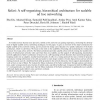Free Online Productivity Tools
i2Speak
i2Symbol
i2OCR
iTex2Img
iWeb2Print
iWeb2Shot
i2Type
iPdf2Split
iPdf2Merge
i2Bopomofo
i2Arabic
i2Style
i2Image
i2PDF
iLatex2Rtf
Sci2ools
ADHOC
2008
2008
Safari: A self-organizing, hierarchical architecture for scalable ad hoc networking
As wireless devices become more pervasive, mobile ad hoc networks are gaining importance, motivating the development of highly scalable ad hoc networking techniques. In this paper, we give an overview of the Safari architecture for highly scalable ad hoc network routing, and we present the design and evaluation of a specific realization of the Safari architecture, which we call Masai. We focus in this work on the scalability of learning and maintaining the routing state necessary for a large ad hoc network. The Safari architecture provides scalable ad hoc network routing, the seamless integration of infrastructure networks when and where they are available, and the support of self-organizing, decentralized network applications. Safari's architecture is based on (1) a self-organizing network hierarchy that recursively groups participating nodes into an adaptive, locality-based hierarchy of cells; (2) a routing protocol that uses a hybrid of proactive and reactive routing informati...
| Added | 08 Dec 2010 |
| Updated | 08 Dec 2010 |
| Type | Journal |
| Year | 2008 |
| Where | ADHOC |
| Authors | Shu Du, Ahamed Khan, Santashil PalChaudhuri, Ansley Post, Amit Kumar Saha, Peter Druschel, David B. Johnson, Rudolf H. Riedi |
Comments (0)

